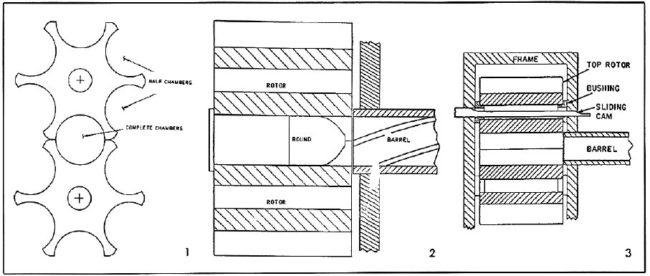The Honeywell Mk.18 mod.0 grenade launcher was developed upon request from the US Navy as a close support weapon for small riverine crafts, which were operating in Vietnam.
The work on a new area denial / close support weapon that could fire new 40mm grenade rounds began in late 1962, shortly after the adoption of the new 40x46mm grenade ammunition and its associated M79 single-shot launcher by the US Military. The new weapon was intended to fire same “low velocity” ammunition, but in continuous bursts instead of single shots, to cover a bigger area in a short period of time.
The new weapon was designed and produced by the American company Honeywell, and it was adopted by the US Navy in 1965 as the 40mm Mk 18 model 0 multiple grenade launcher. It was produced until 1968, with about 1200 units delivered to US military. Many of those launchers saw combat use in Vietnam, either from small riverine boats or from the ground mounts. The weapon was quite effective, but it lacked the range, and so it was soon replaced by the heavier, but much more far-reaching and more lethal Mk.19 automatic grenade launcher that fired 40x53mm High Velocity rounds.
One most unusual thing about the Mk.18 mod.0 grenade launcher was that while it was capable of continuous fire, it was not an automatic gun. Instead, its mechanisms were manually powered by an operator via the crank handle, located on the right side of the gun. Turning the handle caused two large internal rotors to rotate synchronously in opposite directions. Both rotors had six semi-circular half-chambers that formed a single firing chamber behind the barrel around the next fresh round. Rounds were linked together using a synthetic tape belt, and remained linked during the feeding, firing and ejection cycle, caused by the rotation of the rotors. For convenience of loading and unloading the top rotor could be raised up along with the top cover, which was hinged at the front. Rate of fire was easily adjusted by changing the speed with which the operating handle was turned by the shooter.

The feed and the split breech mechanism diagram of the Honeywell Mk.18 mod.0 grenade launcher, with dual counter-rotating rotors
The Honeywell Mk.18 mod.0 grenade launcher was usually installed on the pintle or turret mounts on riverine crafts. Alternatively, it was installed on a standard machine gun tripod M122 for the ground use. Quite a few Mk.18 grenade launchers were combined with a .50-caliber Browning M2HB heavy machine gun on a naval Mark 46 Mod 0 pedestal mount, being bolted above the heavy machine gun. A simple ladder or a ring sight on a folding base was used, since the maximum effective range of the gun was fairly limited, at about 400 meters.
the Honeywell Mk.18 mod.0 grenade launcher, basic specifications